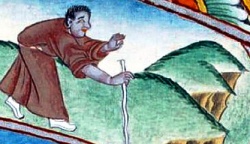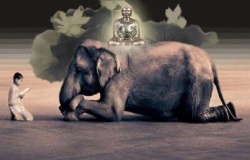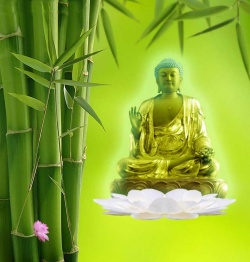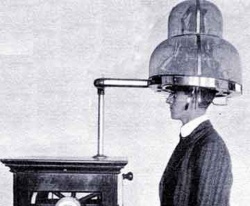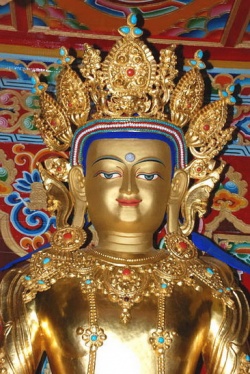Thai Buddhist Calendar
The Thai Calendar
The most notable holidays and festival in Thailand are religious in nature.
Given the fact that Buddhism plays so heavily into Thai festivals, there is plenty of reverence and temple-going during holiday seasons.
Foreigners and non-Buddhists are generally welcome to join in, giving visitors plenty to see, do and experience during Buddhist holidays.
Businesses stay open during most of the annual festivals, but there are about 15 days that bank employees and government workers have off each year. These occur on fixed dates, while the more ancient Buddhist observances are tied to the lunar calendar.
Thai Lunar Calendar
Traditionally, Thailand follows a lunar calendar. King Chulalongkorn adopted a solar calendar in 1888 that had aspects in common with the Western Gregorian calendar while maintaining a few Thai elements as well. For example, years were counted according to the Buddhist era rather than the Christian era.
Buddhist Era Calendar
Since the Buddha lived more than half a millennium before the Common Era, the current Buddhist Era year can be determined by adding 543 to the Western calendar year. The year 2012 is 2555 B.E. (Buddhist Era).
Lunar New Year
Formerly, the transition of the sun into the Aries constellation marked the beginning of the New Year in Thailand. This is according to the Royal Calendar, which is heavily influenced by Brahmanism.
In the 19th century, King Rama V made April 1 the official Thai New Year.
This essentially took the Northern Thai New Year and enacted it on a national level. In the 20th century, King Rama VIII moved the New Year to January 1.
The transition to the solar calendar did not do away with the lunar traditions.
Even today, Thailand’s religious festivals and traditional holidays are held to coincide with important phases of the moon.
In fact, modern Thai calendars are actually a hybrid of solar and lunar calendars. The days are marked according to a 365-day year, but the moon’s full, half and full phases are still indicated on each page.
The Full Moon in the Buddhist Calendar
The most important Buddhist feasts and festivals take place on full moon days, which shift from year to year according to the Gregorian calendar.
Dates of these holidays shift within a range, so it is important to look at the calendar on a given year to see when the actual festivities are taking place.
For example, the Loy Krathong festival of lights is held on the full moon of the 12th lunar month.
This means it nearly always takes place in November, but stating anything more definite than that requires a look at the calendar.
There are a couple of exceptions to the way traditional holidays are scheduled on modern calendars. Songkran, the Thai New Year, was traditionally observed according to lunar phases.
Now, the festival is held on April 13 to 15 each year, regardless of the moon.
Also, the Brahman Ploughing Ceremony is observed in Bangkok every May, but the specific date is determined by a group of royal Brahman astrologers when the Royal Calendar is issued each year.
Otherwise, Thai government and bank holidays are held on fixed days according to the solar calendar.
These include observances such as Constitution Day, the King’s birthday, the Queen’s birthday and Chakri Day.
Days like this are not explicitly religious, and they usually equate to something like a bank holiday. Restaurants and businesses stay open, while post offices, major bank branches, schools and all government offices close.
At the street level, life proceeds as usual. When a festival falls on a Saturday or Sunday, a Friday or Monday is substituted.
Buddhist Holy Days
Buddhist holy days are built into the lunar calendar and observed week to week.
These Buddhist holy days (wan phra) take place four times throughout a lunar cycle, on the new moon, half moon, full moon and half moon again.
They are marked on Thai calendars with tiny full-, half- and new-moon icons.
This is a Theravada Buddhist tradition observed across the region in Thailand, Laos, Cambodia, Myanmar and Sri Lanka.
There are 28 days in a full lunar cycle. Dividing this into four quarters results roughly in four seven-day periods.
However, this doesn’t fit perfectly into the solar week, which is why some Buddhist holy days are seven days apart and others eight.
Every month has four or five Buddhist holy days, but they do not occur on any set day of the week. These holy days are sometimes called Buddha Days in English.
Thai Buddhists go to temple throughout the week, but Buddhist holy days are an especially popular time to visit a temple and make merit.
The full moon is the most important Buddhist holy day, and monks shave their heads the evening before.
It is especially important to embrace the eight or ten precepts and avoid sin on Buddhist holy days, since transgressions are believed to count more heavily on these holy days. During major Buddhist Days that double as important religious festivals, the sale of alcohol is prohibited.
Traditionally, Thai people had every Buddhist holy day off, but the government eventually abolished this practice.
Many people make a point of going to temple, and some of the older traditionalists might avoid alcohol and intoxicants. Otherwise, life goes on as usual.
